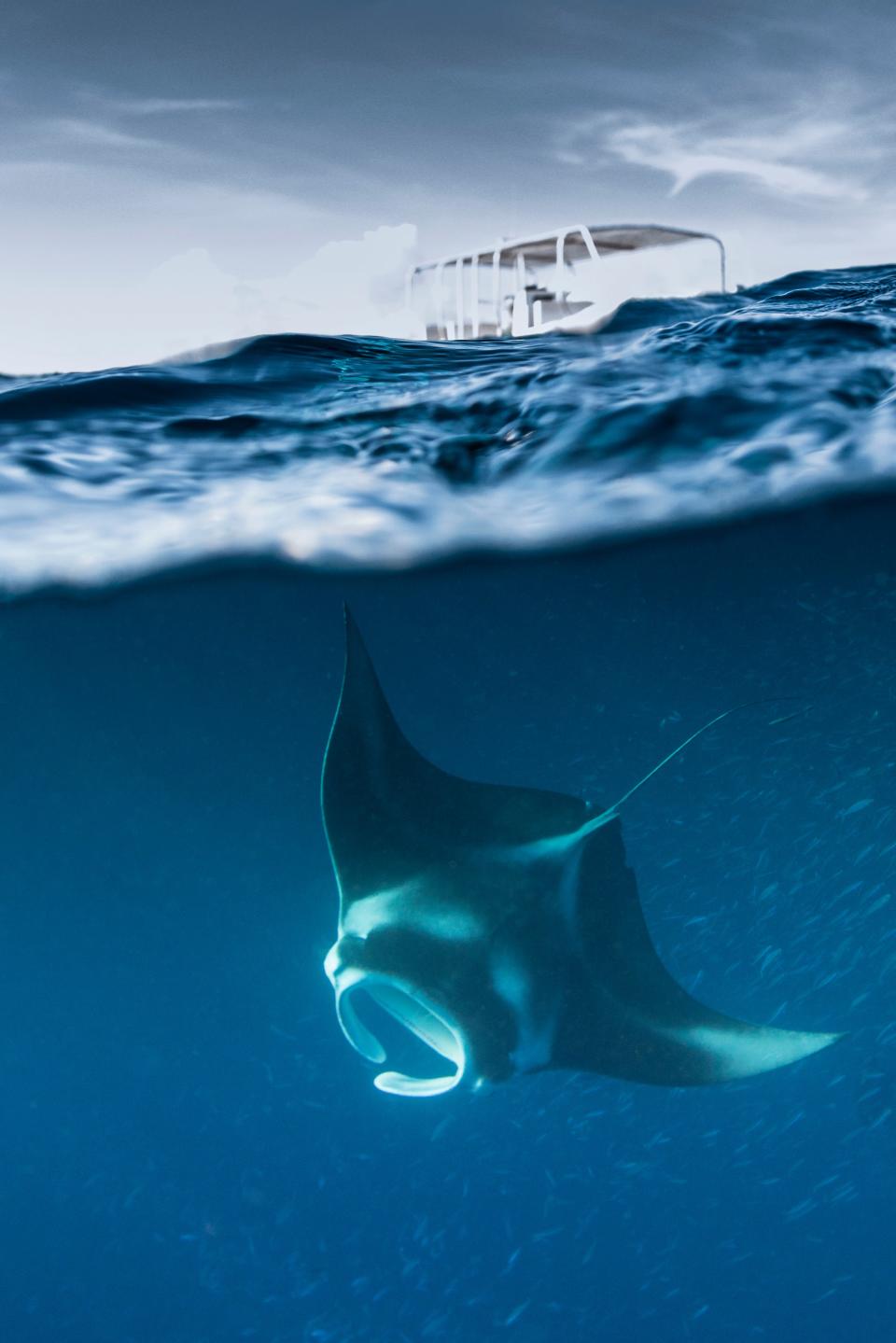Michael Dunker/Getty
Onboard Obsession is a new series that explores the can’t-miss highlights of the best-loved cruises—from the shore excursions to book to the spa treatments too relaxing to pass up.
As soon as my head dips beneath the warm waters of Indonesia’s Bunaken National Marine Park, I hear a mysterious tick-ticking, pop-popping sound that I haven’t experienced before while snorkeling. I quickly kick my flippers to rise. When my ears breach the surface, I hear a Lindblad Expedition leader explaining to some fellow passengers of the National Geographic Resolution that the faint sounds are signs of an extremely healthy coral.
I’m on a 12-day journey from Vietnam to Palau aboard the 138-passenger Resolution, purpose-built to access waterways that would otherwise be impossible without dynamic positioning technology, an X-bow construction, and a team of expedition leaders who negotiate “dockings” like this one, floating within a protected marine reserve with no other vessels in sight.
I dive again beneath the surface to the undersea equivalent of Tokyo’s Shibuya Crossing. Several green and hawksbill turtles are darting in and out of a vibrant coral cliff with seemingly millions of species, from sculpins to sun coral and everything in between. I strain my eyes and urge my brain to take in every detail and somehow lodge each scene into my memory bank. Often I repeat characteristics of sea life to myself while snorkeling so that I can later identify the species back on board, with help from the expedition team and dedicated science center. One kick after another I spot a fish that I never thought I would see outside of a nature documentary: to the left are clownfish in their bubble-tip anemone homes, plus a lionfish, a porcupinefish, an octopus, a school of thousands of Niger triggerfish fluttering their fins like butterflies.
After what feels like hours of playing a marine version of Where’s Waldo, I realize that I have drifted away from the group. I decide to turn and float on my back before catching up in one last-ditch effort to take everything in. The sun-soaked, tropical scene feels like slow motion suddenly, disorienting me in a way that I haven’t felt since I was a child.

The Coral Triangle in the western Pacific is home to nearly 600 coral species and over 2,000 different types of reef fish.
Getty
“That was the most varied snorkeling I’ve ever seen,” says Brett Garner, one of the National Geographic Resolution’s expedition team, as we ride the zodiac back to the ship. That’s a lot coming from a marine biologist who has spent years of his life in a mask and fins. In fact, most of the expedition team had never snorkeled the center of the Coral Triangle due to its extremely remote nature, and were similarly gobsmacked.
As I settle into the hammock on my room’s balcony later that night, savoring a housemade shortbread cookie shaped like a parrot fish, I feel especially reflective. I grew up as a water baby, snorkeling and diving the Caribbean with my family—almost every vacation was somewhere that could take us underwater. But I haven’t really been snorkeling since then, for almost 16 years. Looking out at the mushroom-shaped limestone formations sticking up out of the sea, each with a drapery of vegetation, it’s bittersweet to realize that my renewed wonder for the activity was probably the best I’ll ever experience.
Walking into breakfast the next morning, I spot marine biologist Heather Denham and assistant expedition leader Alexandra Kristjánsdóttir and grab an empty seat at their table. I share my melancholy with them—that I am freshly impassioned but feel like I’ve already seen the pinnacle of snorkeling. They both let out laughs and assure me that there’s always a surprise beneath the surface.
Boy were they right. A few hours later, in Palau’s Rock Islands, I am swimming with fellow passengers aged mid-20s to high 70s, seeing black tip sharks, psychedelic brain coral, giant clams, and playing with stingless jellyfish. At one point, the speed boat captain spots a manta ray. Even though we had been snorkeling all day, we move faster than I’ve seen in the previous 11 days, quickly donning our masks and fins and jumping into the deep blue. The current immediately pulls us as we try to stick close together on the hunt for the ray. “HERE!,” Heather shouts, and I turn around to see an 11-foot manta ray directly in front of me. I’m frozen in movement as it turns up to the surface in a big circle, showing me its underside, before diving deep.
I am greeted at the surface with the hooting and hollering of involuntary happiness brought on by seeing such a magnificent creature in its natural habitat. Heather leans over to me on the boat ride back to the ship, “See, it doesn’t get much better than this, does it?” And as someone who has a difficult time staying present, I can only smile and realize I haven’t felt so in the moment in years.
Originally Appeared on Condé Nast Traveler


